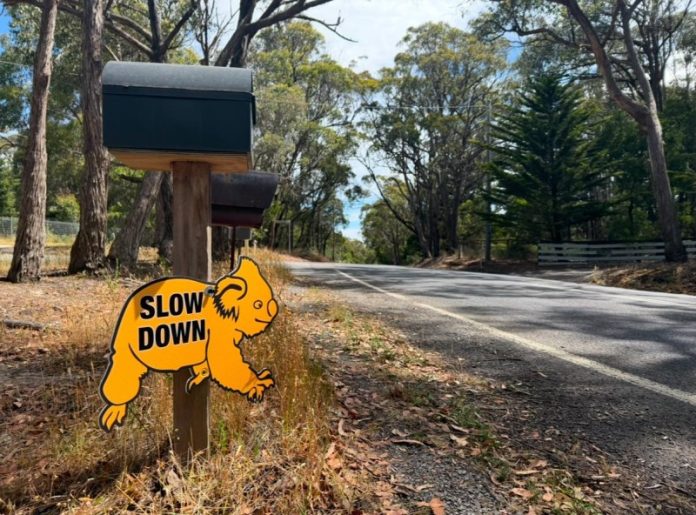Macedon Ranges wildlife rescuers have responded to a spike in koala road strikes with bold signage to warn drivers of hot spots.
The yellow, koala-shaped markers bear the words ‘slow down’ and ‘hot spot’. Their placement indicates a high strike area.
Wildlings Woodend Wildlife Shelter rescuers Mel Fraser and Karl Dawson are leading the project.
Mel said in the past two years, koala rescues in the Macedon Ranges area had tripled.
“We have a low-density koala population, and many long-time residents in the Ranges say they rarely see koalas anymore,” Mel said.
“We needed to do something differently because simply responding to rescue after rescue wasn’t enough anymore.
“These signs are a temporary measure to highlight a growing issue. We hope Regional Roads Victoria and Council will step in to help address it.”
Wildlife rescuers are eager to see the council trial digital signage or other measures but felt the need for an immediate stop-gap.
Macedon Ranges Signs has donated time and materials to help deliver 14 signs in high-risk areas. Signs are already located on Ashbourne Road and Romsey Road. More are expected to be distributed in other locations before the next breeding season when koalas are most vulnerable (September to February).
Mel said Macedon Ranges Shire had one of the highest rates of wildlife collisions in Victoria.
“Previously, most koalas coming into care were older and struggling in the wild but now we’re losing more of them in their prime due to increased road trauma. Since January 1, four breeding males have died from vehicle strikes,” Mel said.
“Most collisions happen at night, and increasing traffic isn’t helping. Urban development in areas like Gisborne and Riddells Creek is also impacting koala habitat and movement.”
Macedon Ranges Shire Council has recognised wildlife road strike as a concern in the shire.
The council was successful in reducing the speed limit of Romsey Road to 80km/h between Romsey and Hanging Rock, in response to community feedback of high wildlife strike.
Council held a Reducing the Wildlife Road Toll forum and rolled out the Wildlife Road Toll Reduction Toolkit, in collaboration with Wildlife Victoria.
Last year the council also called on the Australian Government to include wildlife trauma and fatalities metrics in federal road safety funding models. The motion was carried unanimously at the National General Assembly in Canberra last July.
Mayor Dom Bonanno said the council remained hopeful that its advocacy work would transfer into tangible action over time.
“We know how important this is to many in our community and we are committed to supporting reducing road-related wildlife trauma outcomes,” he said.
WHAT YOU CAN DO
Wildlife are unpredictable and can appear at any time, though they are most active between dusk and dawn.
Drivers are encouraged to pay attention to road signs that indicate wildlife may prevalent and slow down in these areas to minimise risk.
Sometimes wildlife strike is unavoidable. Members of the public can report incidents of sick, injured or orphaned native animals found anywhere across the state to Wildlife Victoria’s 24/7 wildlife emergency response service on (03) 8400 7300.
Wildlife Victoria can provide advice and send a wildlife rescuer to the site.








